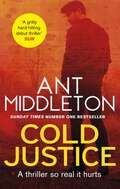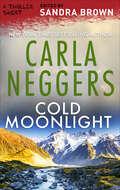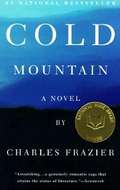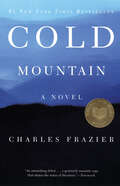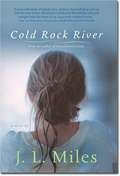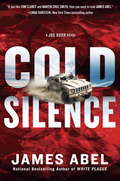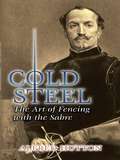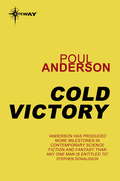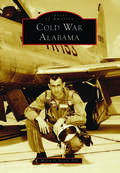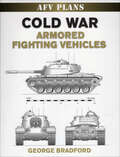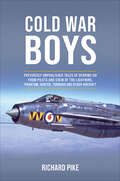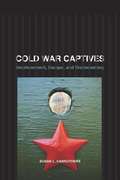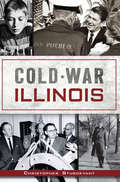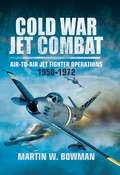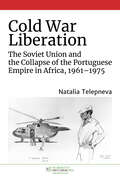- Table View
- List View
Cold Justice: The thriller of the year from the bestselling superstar of SAS: Who Dares Wins (Mallory)
by Ant MiddletonA THRILLER SO REAL IT HURTSIt's here: the landmark debut thriller from superstar Ant Middleton, million-selling, number one Sunday Times author of First Man In and The Fear Bubble and star of SAS: Who Dares Wins.Mallory - he was the best of the best, a Special Forces leader and a hero. But then he made a fatal decision, gambling with the lives of his men with terrible consequences: two dead, and his young friend Donno left in a coma. Back on the streets, with nothing to lose, Mallory has a darkness growing inside him, a dangerous need to seek out trouble. Then Donno's mother asks him for help: her other son, Scott, has gone missing in South Africa, and she wants Mallory to find him.Perhaps it's redemption, perhaps he's looking for revenge on the world, but suddenly Mallory has a purpose, and nothing and no one is going to stand in his way.'A white-knuckler' -- GREGG HURWITZ'A real page-turner with a bang of a finish' -- SIMON KERNICK'A pressure cooker of thrills, excitement and fear' -- MARK DAWSON
Cold Moonlight (The Thriller Shorts #1)
by Carla NeggersA veteran Navy SEAL is on the trail of a mystery in the woods of Vermont in this romantic suspense short story by a New York Times–bestselling author.In this emotional Thriller Short, New York Times–bestselling writer Carla Neggers delivers an intense, emotional read. Navy SEAL Ryan “Grit” Taylor survived the war in Afghanistan but lost a limb. Now, at her brother’s urging, Grit is on a mission to save the life of Marissa, a history teacher who also happens to be the vice president’s oldest daughter and the love of Grit’s life. In the snow-laden forest of Vermont, an associate with a shoulder wound confirms that a sniper is after Marissa. A blood trail warns Grit that either she or the sniper has been injured. But on finding her, Grit must grapple with an entirely different crisis. Who is the actual target?Originally published in Love is Murder (2013), edited by #1 New York Times–bestselling author Sandra Brown.Praise for Love is Murder“If a person is known by the company she keeps, then the company of the 30 romance and suspense writers in this stellar all-original anthology speaks volumes about bestseller Brown . . . . Chockablock with nifty plot twists, these stories aren’t to be missed.” —Publishers Weekly (starred review)
Cold Mountain
by Charles FrazierOne of the most acclaimed novels in recent memory, Charles Frazier's Cold Mountain is a masterpiece that is at once an enthralling adventure, a stirring love story, and a luminous evocation of a vanished American in all its savagery, solitude, and splendor. <P><P> Sorely wounded and fatally disillusioned in the fighting at Petersburg, Inman, a Confederate soldier, decides to walk back to his home in the Blue Ridge Mountains and to Ada, the woman he loved there years before. His trek across the disintegrating South brings him into intimate and sometimes lethal converse with slaves and marauders, bounty hunters and witches, both helpful and malign. At the same time, Ada is trying to revive her father's derelict farm and learn to survive in a world where the old certainties have been swept away. As it interweaves their stories, Cold Mountain asserts itself as an authentic American Odyssey--hugely powerful, majestically lovely, and keenly moving.<P> Winner of the National Book Award
Cold Mountain: A Novel
by Charles FrazierA wounded Confederate soldier treks across the ruins of America in this National Book Award–winning novel: &“A stirring Civil War tale told with epic sweep.&” —People Sorely wounded and fatally disillusioned in the fighting at Petersburg, a Confederate soldier named Inman decides to walk back to his home in the Blue Ridge mountains to Ada, the woman he loves. His journey across the disintegrating South brings him into intimate and sometimes lethal converse with slaves and marauders, bounty hunters and witches, both helpful and malign. Meanwhile, the intrepid Ada is trying to revive her father&’s derelict farm and learning to survive in a world where the old certainties have been swept away. As it interweaves their stories, Cold Mountain asserts itself as an authentic odyssey, hugely powerful, majestically lovely, and keenly moving.
Cold Rock River
by J. L. MilesIn 1963 rural Georgia, with the Vietnam War cranking up, pregnant seventeen-year-old Adie Jenkins discovers the diary of pregnant seventeen-year-old Tempe Jordan, a slave girl, written as the Civil War wound down. As "Cold Rock River" comes to its surprising, shocking, endings, questions of family, race, love, loss, and longing are loosed from the mysterious secrets that have been kept for too long and the depth of the mysterious connection between two women united by place and separated by race and a hundred years is revealed.
Cold Shot: A Novel (a Jonathan Burke/Kyra Stryker Thriller)
by Mark HenshawWith “searing action” (Publishers Weekly) and “lead characters [who] are fleshed out and interesting, especially the decidedly Sherlock-ian Burke” (Kirkus Reviews), Mark Henshaw delivers the ingenious follow-up to his debut novel, Red Cell, featuring two CIA analysts on the hunt for a dangerous nuclear scientist.The USS Vicksburg is returning home when the crew comes upon a lifeboat bearing a dead Somali pirate who shows signs of torture. Questions immediately arise: Who is this man, and which ship did he come from? Who tortured him? Soon Red Cell analysts Kyra Stryker and Jonathan Burke have traced the dead man back to an Iranian ship currently bound for Venezuela—and the ship appears to have dangerous, radioactive cargo on board. The Iranians’ plan quickly becomes clear—they’re building a nuclear bomb in politically unstable Venezuela, away from the UN’s prying eyes. Stryker and Burke must tread carefully, though, because diplomacy in Venezuela is tricky at best. A civil war is at stake if word gets out. Can they stop the Iranians before it’s too late? From current CIA analyst and Red Cell think tank veteran Mark Henshaw, Cold Shot is “tense, suspenseful, and loaded with immersive detail” (Kirkus Reviews)—a thrilling journey into the intelligence world that only a true insider could create.
Cold Silence (Joe Rush #3)
by James AbelJames Abel--author of the electrifying Joe Rush novels Protocol Zero and White Plague--unleashes another heartstopping thriller in which an unholy plague from the past has been awakened...While trying to alleviate the suffering of thousands in drought-stricken, war-torn Africa, ex-Marine doctor and bio-terror expert Joe Rush receives a plea for help from a member of his old military unit, currently working as a geologist in a chaotic region of Somalia.Joe arrives on the scene to find an entire group showing horrific symptoms of an ancient sickness once thought to be sent as punishment from heaven. But before Joe can get hard evidence identifying the illness, a local warlord takes matters into his own hands--and the proof is gone just as the illness breaks out back in the United States.This outbreak is not a curse from God. It's a well-coordinated, meticulously planned attack with a specific goal that could overturn global stability and kill millions. And the only one who can stop the downfall of civilization is Joe Rush...From the Hardcover edition.
Cold Steel: The Art of Fencing with the Sabre (Dover Military History, Weapons, Armor Ser.)
by Alfred Hutton Ramon MartinezA pioneer of modern fencing, Alfred Hutton was the first president of the Amateur Fencing Association and a father of modern research into the Western combat arts. In addition to his lectures about ancient weapons and his demonstrations of their use, Hutton created this 1889 classic, a continuing source of instruction and enlightenment to modern readers.The techniques associated with the sabre differ markedly from those of the épeé and the rapier. This study offers both technical and historical views of the art of the sabre. It begins with a look at the weapon's construction and its grip, followed by explanations of a variety of different strokes and parries as well as methods of combining attack and defense. Additional topics include approaches suitable for left-handed fencers, ceremonial aspects of the art, and contrasts between the sabre, the bayonet, and the French sword. Descriptions of associated weapons cover the great stick and the constable's truncheon, and the book concludes with considerations of the short sword-bayonet, or dagger. Fifty-five illustrations demonstrate how to hold the sabre, how to parry and guard, seizure, and numerous other aspects of the art of fencing with a sabre.
Cold Victory: Psychotechnic League Book 5 (PSYCHOTECHNIC LEAGUE)
by Poul AndersonBorn in the radioactive ashes of World War Three the institute for Applied Psychodynamics had guided Planet Earth to a period of plenty that for the first time fulfilled Science's promise. But it is the central irony of human existence that prosperity bears the seeds of its own destruction; this time not just Earth but the entire Solar System would endure the flames of war.
Cold War (Images of the The National Archives)
by Stephen TwiggeThis documentary history from the UK National Archives captures the evolution of the Cold War through captivating images and declassified documents.In Cold War, Stephen Twigge explores the tense confrontation of global superpowers from the end of the Second World War to the collapse of the Soviet Union. It was a time when military and ideological struggles between the United States and the Soviet Union dominating the postwar landscape. But Twigge also highlights the role played by Britain in major events such as the Berlin Blockade, the Cuban Missile Crisis and the Soviet invasion of Afghanistan. Cold War describes the devastating consequences of nuclear war, the growth and influence of the peace movement and the exploits of the Cold War spy networks built up by both sides. Based on declassified government reports and papers, the book tells a compelling story of global conflict and superpower politics set against a backdrop of dramatic social and cultural change.
Cold War (Power Plays #5)
by Tom Clancy Martin H. Greenberg Jerome PreislerUnspoiled. Uninhabited. Under attack... On the wind-swept, ice-covered continent of Antarctica, Roger Gordian's UpLink Technologies has established a scientific research facility called Cold Corners. But its testing of potential robotic landing craft for use on Mars is disrupted when one of the rovers disappears--along with the repair team sent out after it. Fear of discovery has prompted a renegade consortium--that is illegally using Antarctica as a nuclear waste dump--to wipe out the UpLink base. Now, the men and women of Cold Corners have only themselves to rely on as the consortium mounts its decisive strike against the ice station--and the final sunset plunges them into the total darkness of a polar winter...
Cold War Alabama (Images of America)
by Melvin G. Deaile PhDThe 50-year Cold War began following World War II and was a struggle between ideologies, militaries, economies, athletes, and each nation's ability to reach space. Alabama played a key role in that conflict. Huntsville led the efforts in ballistic missile as well as rocket propulsion development. From Enterprise to Montgomery to Anniston, the military prepared for and served in battles abroad. While the United States promoted democracy globally, the civil rights movement fought for a "more perfect union" at home. Not everyone supported the US involvement in proxy wars; groups of college students in Alabama protested the Vietnam War. All these aspects of the Cold War are captured from across Alabama through pictures and words. Melvin G. Deaile, PhD, is an associate professor at the Air Command and Staff College in Montgomery, Alabama. A retired US Air Force colonel, he holds a doctorate in American history from the University of North Carolina at Chapel Hill. He holds master's degrees from Louisiana Tech University, the US Army Command and General Staff School, the Air Force School of Advanced Air and Space Studies, and University of Alabama. He flew the B-52 Stratofortress and the B-2 Spirit and combat operations as part of Operations Desert Storm and Enduring Freedom, including a record-setting 44.3-hour combat mission. His first book, Always at War , chronicles Strategic Air Command's contributions to the Cold War. The Alabama Department of Archives and History provided the majority of this book's images.
Cold War Armored Fighting Vehicles (AFV Plans)
by George BradfordFor modelers and military enthusiasts, a collection of scale drawings of post-WWII 20th century military vehicles. This volume of scale drawings of military vehicles covers the Cold War, from the end of World War II through 1990. Included here are the armored fighting vehicles that fought in Korea and Vietnam, in the Arab-Israeli wars, and in other conflicts around the globe, as well as those that never saw combat. Vehicles include: · Centurion main battle tank (Britain) · Leopard 2 main battle tank (Germany) · Magach 6 tank (Israel) · T-55 main battle tank (Soviet Union) · M47 Patton medium tank (United States) · And dozens more . . .
Cold War Boys: Previously Unpublished Tales of Derring-Do from Pilots and Crew of the Lightning, Phantom, Hunter, Tornado and Other Aircrafts
by Richard PikeWhen the US president, Harry S Truman, declared the Truman Doctrine in March 1947, he could not have known that the resultant Cold War would persist for over 40 years until the dissolution of the Soviet Union in December 1991. In addition to nuclear and conventional military friction between the Eastern and Western blocs, the struggle for dominance involved a remarkable range of activities including the space race, psychological efforts, espionage, even rivalry at sporting functions and technological events. This diversity is reflected in the 20 chapters of Cold War Boys which opens with a vivid description from the author of survival procedures used by English Electric Lightning pilots in the event of nuclear war. From there on, various contributors share their original experiences on a range of fixed-wing aircraft and rotorcraft across the world including tales from RAF Germany, the Falklands and the Far East. Each story demonstrates some of the intriguing circumstances faced by aircrew and ground crew whose tenacity and professionalism had to cope with miscellaneous situations of danger, excitement, risk, pathos and humor. This book serves as a reminder of what air forces faced during the Cold War years as the ever-present threat of nuclear war persisted. A must for all aviation fans.
Cold War Captives: Imprisonment, Escape, and Brainwashing
by Susan L. CarruthersThis book explores the ways in which east-west disputes over prisoners, repatriation, and defection shaped popular culture. Captivity became a way to understand everything from the anomie of suburban housewives to the "slave world" of drug addiction.
Cold War Christians and the Spectre of Nuclear Deterrence, 1945–1959
by Jonathan GorryThis book offers a new and provocative interpretation of early Cold War history by demonstrating how Christian agency played a pivotal role in the creating of space for the logic of nuclear deterrence and nuclear war fighting in the years 1945-59. Cold War chroniclers have traditionally placed great emphasis on threats of mutually assured destruction to explain the puzzle of nuclear non-use since 1945. Here nuclear deterrence is conceived as a realm of absolute necessity with no room for morality. More recently the idea of 'nuclear taboo' has generated immense interest by challenging conventional wisdom with a compelling argument regarding the conceptual (normative rather than material) bases of nuclear restraint. These accounts narrate the emergence of a distinctive ethical order with a particular premium placed on the role of (Anglo-American) Christian activists in giving rise to anti-nuclear sentiment at a formative stage 1945-59. Yet such a reading elides or obfuscates the fact that Christians were deeply divided in their imaginings. Gorry invites a reassessment of assumptions by offering a balanced examination of Christians as enablers but, more provocatively, as resisters of nuclear prohibitions in the early years of Cold War.
Cold War Command: The Dramatic Story of a Nuclear Submariner
by Richard Woodman Dan ConleyA British nuclear submariner sheds critical light on the Royal Navy&’s Cold War operations in this revealing military memoir. The role played by the Royal Navy's submarines throughout the Cold War remains largely shrouded in secrecy. In Cold War Command, Captain Dan Conley, RN (Ret.), offers an insider&’s look at commanding nuclear hunter-killer submarines. As captain of the HMS Courageous and HMS Valiant, Conley was tasked with covertly following Soviet submarines in order to destroy them should there be any outbreak of hostilities. Conley recounts his early career in diesel submarines, as well as his exceptional success against the Soviet Navy at the height of the Cold War. He was involved in the initial deployment of the Trident nuclear weapon system and divulges previously unknown facets of nuclear weapons strategy and policy during this period. He also describes the Royal Navy's shortcomings in ship and weapons procurement, assessing how these failures led to the effective bankrupting of the Defense budget as it entered the 21st century.
Cold War Crucible: The Korean Conflict and the Postwar World
by Masuda HajimuAfter World War II, the major powers faced social upheaval at home and anti-colonial wars around the globe. Alarmed by conflict in Korea that could change U.S.-Soviet relations from chilly to nuclear, ordinary people and policymakers created a fantasy of a bipolar Cold War world in which global and domestic order was paramount, Masuda Hajimu shows.
Cold War Encounters in US-Occupied Okinawa
by Mire KoikariIn this innovative and engaging study, Mire Koikari recasts the US occupation of Okinawa as a startling example of Cold War cultural interaction in which women's grassroots activities involving homes and homemaking played a pivotal role in reshaping the contours of US and Japanese imperialisms. Drawing on insights from studies of gender, Asia, America and postcolonialism, Koikari analyzes how the occupation sparked domestic education movements in Okinawa, mobilizing an assortment of women – home economists, military wives, club women, university students and homemakers – from the US, Okinawa and mainland Japan. These women went on to pursue a series of activities to promote 'modern domesticity' and build 'multicultural friendship' amidst intense militarization on the islands. As these women took their commitment to domesticity and multiculturalism onto the larger terrain of the Pacific, they came to articulate the complex intertwinement of gender, race, domesticity, empire and transnationality that existed during the Cold War.
Cold War Illinois
by Christopher SturdevantFrom Walt Disney and Ronald Reagan to chess matches and Nike missiles, trace the Illinois roots of prominent players in the longest and costliest conflict in American history. Discover a mobster's involvement in assassination attempts of Cuban leader Fidel Castro and how the nuclear age began at a college football field on Chicago's south side. Visit the graves of Communist Party leaders and the high-alert heritage of military bases across the state. Local author Christopher Sturdevant, chairman of the Midwest Chapter of the Cold War Museum, follows up his look into Cold War Wisconsin with its neighbor to the south in a fascinating tale of Illinois's role in the fight between East and West.
Cold War Jet Combat: Air-to-Air Jet Fighter Operations, 1950–1972
by Martin W. BowmanRecounted here are nine of the earliest wars involving jet aircraft. From the Korean War and beyond, it comprises a wealth of gripping insight. Many of the jet-to-jet dogfights that spanned these jet-powered wars are enlivened to thrilling effect, including those engaged in during the two Indo-Pak Wars of 1965 and 1971. Operation Musketeer (1956), mounted when RAF and French Air Force bombers and fighter-bombers attacked airfields and other targets in Egypt (after President Nasser had nationalised the Suez Canal), is also covered in this gripping narrative. The Falklands Campaign is also covered, as is the Vietnam War. In another chapter, QRA operations around the British Isles are put under the microscope as RAF Phantoms, Lightnings, Tornadoes and Typhoon Eurofighters on Quick Reaction Alert are described, patrolling international air space and maintaining a constant vigil as Soviet Bears continued to test NATO defences. All in all, this is a compelling, well-researched and highly informative study of a particularly dynamic era in aviation history.
Cold War Kansas (Military)
by Landry BrewerKansas played an outsized role in the Cold War, when civilization's survival hung in the balance. Forbes Air Force Base operated nine Atlas E intercontinental ballistic missile launch sites. Schilling Air Force Base was the hub for twelve Atlas F ICBMs. McConnell Air Force Base operated eighteen Titan II ICBMs. A Kansas State University engineering professor converted a discarded Union Pacific Railroad water tank into his family's backyard fallout shelter. A United States president from Kansas faced several nuclear war scares as the Cold War moved into the thermonuclear age. Landry Brewer tells the fascinating story of highest-level national strategy and how everyday Kansans lived with threats to their way of life.
Cold War Liberation: The Soviet Union and the Collapse of the Portuguese Empire in Africa, 1961–1975 (New Cold War History)
by Natalia TelepnevaCold War Liberation examines the African revolutionaries who led armed struggles in three Portuguese colonies—Angola, Mozambique, and Guinea-Bissau—and their liaisons in Moscow, Prague, East Berlin, and Sofia. By reconstructing a multidimensional story that focuses on both the impact of the Soviet Union on the end of the Portuguese Empire in Africa and the effect of the anticolonial struggles on the Soviet Union, Natalia Telepneva bridges the gap between the narratives of individual anticolonial movements and those of superpower rivalry in sub-Saharan Africa during the Cold War. Drawing on newly available archival sources from Russia and Eastern Europe and interviews with key participants, Telepneva emphasizes the agency of African liberation leaders who enlisted the superpower into their movements via their relationships with middle-ranking members of the Soviet bureaucracy. These administrators had considerable scope to shape policies in the Portuguese colonies which in turn increased the Soviet commitment to decolonization in the wider region. An innovative reinterpretation of the relationships forged between African revolutionaries and the countries of the Warsaw Pact, Cold War Liberation is a bold addition to debates about policy-making in the Global South during the Cold War. We are proud to offer this book in our usual print and ebook formats, plus as an open-access edition available through the Sustainable History Monograph Project.
Cold War Long Island (Military)
by Karl Grossman Christopher VergaBy the close of World War II, Long Island had transformed from a rural corridor to a suburban behemoth. The region became a nationally recognized manufacturing and innovation hub for the military and possessed one of the fastest-growing middle-class populations in the country. But behind the manicured lawns and cookie-cutter cape homes, locals were adapting to new Cold War conflicts and facing anxieties of a potential nuclear fallout. Secret nuclear missile sites and classified government laboratories were established on the outskirts of Suffolk County, often among unaware residents. Soviet spy rings traversed across the island, seeking to steal industry secrets and monitor military installations. Author Christopher Verga and veteran journalist Karl Grossman bring to life the often overlooked history of the Cold War era in Nassau and Suffolk Counties.
Cold War Massachusetts (Military)
by Joshua ShanleyMassachusetts played a pivotal role during the Cold War era. In 1957, the Strategic Air Command established the Notch Bunker, a three-story hardened facility built into the Holyoke Mountain Range near Westover Air Force Base. The state led the nation with a groundbreaking $3 million underground Emergency Operations Center in Framingham, dedicated on November 16, 1963, designed to run state government post-nuclear blast, capable of withstanding a twenty-megaton missile explosion within three miles. In 1964, AT&T constructed a forty-thousand-square-foot underground bunker in Chesterfield, built for both military and civilian purposes, intended to resist nuclear, biological and chemical attacks. By 1966, there were a total of 6,623 fallout shelters in Massachusetts. Utilizing vintage photographs and maps, local author Joshua Shanley explores the state’s bunkers, bases and missile silos and their impact on current emergency planning.
